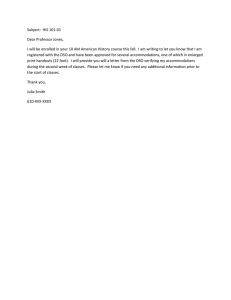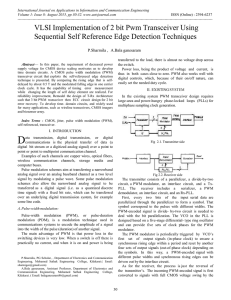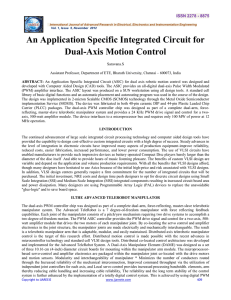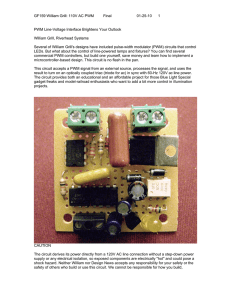Pulse Width...Pulse Width Modulation
advertisement
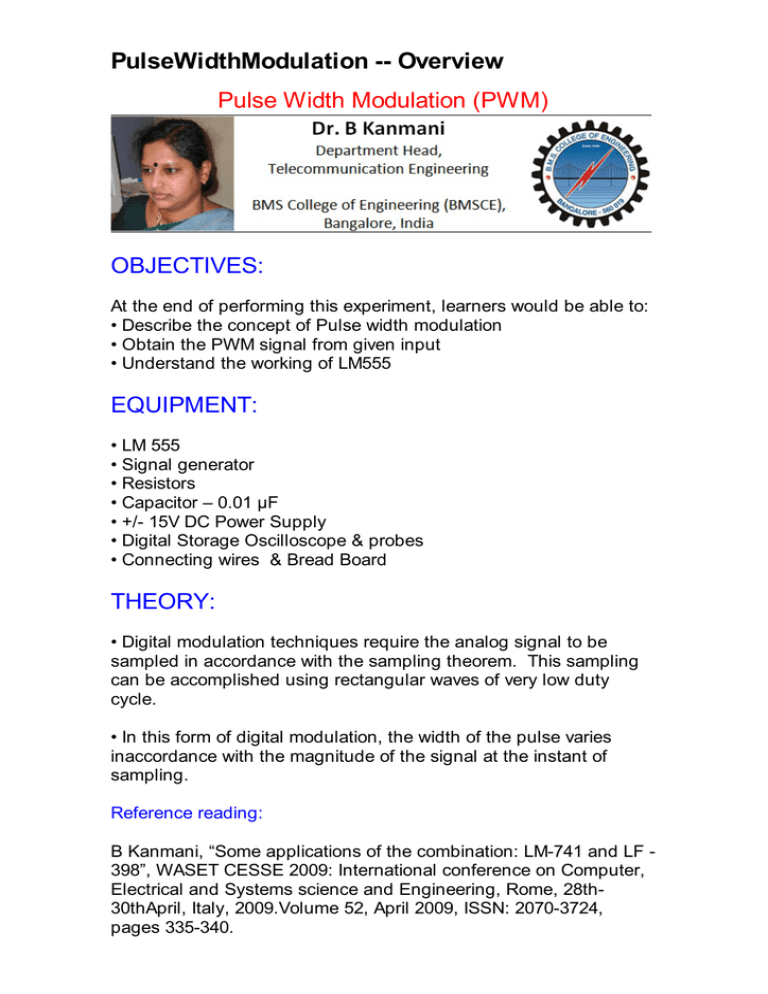
PulseWidthModulation -- Overview Pulse Width Modulation (PWM) OBJECTIVES: At the end of performing this experiment, learners would be able to: • Describe the concept of Pulse width modulation • Obtain the PWM signal from given input • Understand the working of LM555 EQUIPMENT: • LM 555 • Signal generator • Resistors • Capacitor – 0.01 µF • +/- 15V DC Power Supply • Digital Storage Oscilloscope & probes • Connecting wires & Bread Board THEORY: • Digital modulation techniques require the analog signal to be sampled in accordance with the sampling theorem. This sampling can be accomplished using rectangular waves of very low duty cycle. • In this form of digital modulation, the width of the pulse varies inaccordance with the magnitude of the signal at the instant of sampling. Reference reading: B Kanmani, “Some applications of the combination: LM-741 and LF 398”, WASET CESSE 2009: International conference on Computer, Electrical and Systems science and Engineering, Rome, 28th30thApril, Italy, 2009.Volume 52, April 2009, ISSN: 2070-3724, pages 335-340. Acknowledgement Mr.Shreenivas B for converting laboratory experiment to Tektronix courseware format PulseWidthModulation -- Procedures Step 1 • Given fm, choose fs>10fm • Design the astable multivibrator of figure 2, for frequency fs, and about 10% duty cycle Step 2 • The output of the astable acts as the trigger input to figure 4 • The input signal m(t), of fm Hz is provided as in figure 4, and the output PWM obtained • Figure 3 gives the relation between the input trigger and output PWM. The width TM varies with the amplitude of the modulating signal m(t) of frequency fm. Step 3 Circuit setup: Build the following circuit with given designed values Step 4 • Turn on the supply of the circuit • Connect the DSO probe – CH1 at Astable output (pin # 3 of LM555 IC), • Perform Autoset on DSO and capture the output signal. Step 5 • Configure PEAK-to-PEAK measurement on the input and output signal. • Record the measurement and Observe – output on DSO Step 6 Step 7 Circuit setup: Build the following circuit with given designed values Step 8 • Turn on the supply of the circuit • Turn on the supply of the circuit • Connect the DSO probe – CH1 at trigger input (pin # 2 of LM555 IC), CH2 at Analog input (pin # 5 of LM555 IC), CH2 at PWM output (pin # 3 of LM555 IC) Step 9 • Perform Autoset on DSO and capture the output signal. • Configure PEAK-to-PEAK measurement on the input and output signal. • Record the measurement and Observe – output on DSO Step 10 Step 11 Observations: 1. Record the sinusoidal signal and the PWM waveforms on the same graph 2. Demonstrate PWM for a sinusoidal signal of frequency ………… 3. Compare PAM and PWM in terms of noise immunity. 4. Compare PAM and PWM in terms of application to TDM. Open-ended Question / Can you answer this? What will be the effect on output waveform if: 1) Capacitor value is changed from 0.01 µF to 1 µF?



